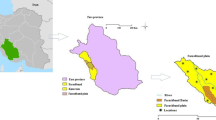Abstract
Hydrological and geological aspect of the region play vital role for water resources utilization and development. Protection and management of groundwater resources are possible with the study of spatio-temporal water quality parameters. The study was undertaken to assess the deterioration in groundwater quality, through systematic sampling during post monsoon seasons of the year 2008 by collecting water samples from thirty bore wells located in Dwarka, sub-city of Delhi, India. The average concentrations of groundwater quality parameters namely Calcium (Ca2+), Magnesium (Mg2+), Nitrate (NO3 −), Chloride (Cl−), sulphate (SO4 2−), total hardness (TH), total dissolved solids (TDS), and electrical conductivity were 300, 178, 26.5, 301, 103, 483, 1042 mg/l and 1909 μS/cm respectively. Estimated physico-chemical parameters revealed that 7 % of the groundwater samples shown nitrate concentrations higher than safe limit prescribed by World Health Organization (WHO). Groundwater quality the in study region was poor due to come out result that NO3 − concentration exceeding the threshold value of 50 mg/l, and main cause is disposal of sewage and animal wastes to Najafgarh drain. Dominant cations are Mg2+, Ca2+ and anions are SO4 2− and Cl−. The abundance of the major ions in groundwater is in the order: Ca2+ > Mg2+ and Cl− > SO4 2− > NO3. TH have strong correlation with Ca2+ (r = 0.81), Mg2+ (r = 0.82), Cl− (r = 0.86) but poor correlation with TDS (r = 0.52). Knowledge of correlation values between water quality parameters is helpful to take decision of appropriate management strategy for controlling groundwater pollution.





Similar content being viewed by others
References
E. Barca, G. Passarella, Spatial evaluation of the risk of groundwater quality degradation. A comparison between disjunctive kriging and geostatistical simulation. Environ. Monit. Assess. 137, 261–273 (2008)
A.N. Jerry, Basic environmental technology (water supply, waste disposal and pollution control) (Wiley, New York, 1986)
A.O. Aksoy, T. Scheytt, Assessment of groundwater pollution around Torbali, Izmir, Turkey. Environ. Geol. 53, 19–25 (2007). doi:10.1007/s00254-006-0614-5
R. Kumari, A. Kaur, D. Mallick, R.K. Singh, S. Nijhawan, Restoration and management study of water bodies in the west district of NCT-Delhi. Int. J. Curr. Microbiol. Appl Sci. 3(7), 938–944 (2014)
P.S. Datta, D.L. Deb, S.K. Tyagi, Assessment of groundwater contamination from fertilizers in the Delhi area based on 18O, NO3 and K+ composition. J. Contam. Hydrol. 27, 249–262 (1997)
S. Shekhar, A. Sarkar, Hydrogeological characterization and assessment of groundwater quality in shallow aquifers in vicinity of Najafgarh drain of NCT Delhi. J. Earth Syst. Sci. 122(1), 43–54 (2013)
I.S. Babiker, M.A.A. Mohamed, T. Hiyama, Assessing groundwater quality using GIS. Water Resour. Manag. 21, 699–715 (2007). doi:10.1007/s11269-006-9059-6
INSA de Lyon, Strategies for water supply in a planned urban extension A case study of the Dwarka sub-city in Delhi. Report, (2004)
EIA Report, Rapid environmental impact assessment report for proposed new GGSIP University Campus at Sector 16-C, Dwarka, New Delhi, (2006)
REIA (Rapid Environmental Impact Assessment, Study for proposed integrated complex for Delhi Judicial Academy (National Law School and National Institute for Mediation & Conciliation, Dwarka, 2006)
P. Mandal, R. Upadhyay, A. Hasan, Seasonal and spatial variation of Yamuna River water quality in Delhi, India. Environ. Monit. Assess. 170, 661–670 (2010)
V.K. Tripathi, T.B.S. Rajput, N. Patel, Lata, Hydraulic performance of drip irrigation system with municipal wastewater. J. Agric. Eng. 48(2), 15–22 (2011)
APHA, Standard methods for the examination of water and wastewater (American Public Health Association, Washington, DC, 1992)
B.R. Yadav, D. Singh, in Analysis of irrigation waters for quality assessment, ed. by H.L.S Tandon (Fertiliser Development and Consultation Organisation, Pamposh Enclave, New Delhi, 2005), pp. 112–152
N. Kumar, D.K. Sinha, Drinking water quality management through correlation studies among various physio-chemical parameters: a case study. Int. J. Environ. Sci. 1(2), 253–259 (2010)
C.J. Rabinove, R.H. Longford, J.W. BrookHart, Saline water resource of North Dakota U.S. Geol. Sur. Water Supply Paper 1428, 72 (1958)
A. Kumar, U.P. Shahi, B.P. Dhyani, R.K. Naresh, B. Singh, Y. Kumar, S. Sardar, Quality assessment of ground water in PMDE treated farm land for drinking purpose. Plant Arch. 11(1), 187–191 (2011)
S. Mor, R. Khaiwal, R.P. Dahiya, A. Chandra, Leachate characterization and assessment of groundwater pollution near municipal solid waste landfill site. Environ. Monit. Assess. 118, 435–456 (2006)
J.E. Harbison, Ground water chemistry and hydrological processes within a quaternary coastal plain: Pimpama, South East Queensland. Ph.D thesis submitted to School of Natural Resource Sciences, Queensland University of Technology, 2007
D. Evans, I.R. Moxon, J.H.C. Thomas, Groundwater nitrate contaminants from the old Chalford Nitrate Sensitive Area, West Oxfordshire. J. Inst. Water Environ. Manag. 7, 507–512 (1993)
M.H. Ward, T.M. De Kok, P. Levallios, J. Brender, G. Gulis, B.T. Nolan, J. Vander Slice, Drinking water nitrate and health-recent findings and research needs. Environ. Health Perspect. 113, 1607–1614 (2005)
WHO, Guidelines for drinking-water quality, 3rd edn. (World Health Organization, Geneva, 2004)
G. Gilli, G. Corrao, S. Faviui, Concentrations of nitrates in drinking water and incidence of gastric carcinomas first descriptive study or the Piemonte Region, Italy. Sci. Total Environ. 34, 35–48 (1984)
W. Grant, G. Steele, S.A. Isiorho, Spontaneous abortions possibly related to ingestion of nitrate-contaminated well water language country, Indiana, 1991–1994. Morb. Mortal. Wkly. Rep. 45, 569–572 (1996)
D.K. Mueller, D.R. Helser, Nudrienty in the nation’s water-too much of a good thing? U.S. Geological Survey circular 1136 (United States Geological Survey, Denver, 1996)
D.N. Mueller, P.A. Hamilton, D.R. Helsel, K.J. Hitt, B.C. Reddy, Nutrients in ground water and surface water of the united states—an analysis or data through 1992, water-resources investigations report 95-4031 (United State Geological Survey, Denver, 1995)
Author information
Authors and Affiliations
Corresponding author
Rights and permissions
About this article
Cite this article
Rawat, K.S., Tripathi, V.K. Hydro-chemical Survey and Quantifying Spatial Variations of Groundwater Quality in Dwarka, Sub-city of Delhi, India. J. Inst. Eng. India Ser. A 96, 99–108 (2015). https://doi.org/10.1007/s40030-015-0116-0
Received:
Accepted:
Published:
Issue Date:
DOI: https://doi.org/10.1007/s40030-015-0116-0



